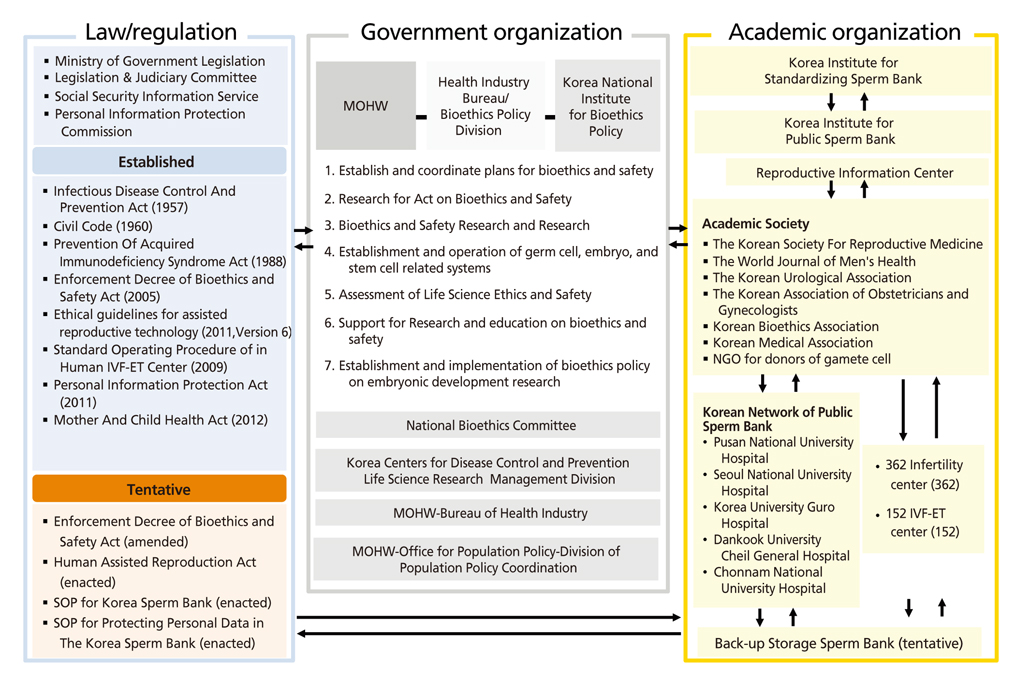J Korean Med Assoc.
2018 Jul;61(7):408-415. 10.5124/jkma.2018.61.7.408.
Reasons of shortage for donated sperm and plan to resolve deficiencies in the sperm donor system
- Affiliations
-
- 1Department of Urology, Pusan National University School of Medicine, Pusan, Korea. pnc@pusan.ac.kr
- 2Korea Institute of Public Sperm Bank, Pusan, Korea.
- KMID: 2416411
- DOI: http://doi.org/10.5124/jkma.2018.61.7.408
Abstract
- Sperm banking from recruited donors is an important way to help infertile couples who want to achieve pregnancy by therapeutic artificial insemination, even in the era of in vitro fertilization. Korea has the lowest population density of newborns among all Organization for Economic Co-operation and Development countries, with a total fertility rate of 1.17 and an annual birth rate of 300,000 or less as of 2017. This situation emerged due to various causes, including late marriage, fecundity problems, and air pollution. Nevertheless, we have imposed strict limits on basic research and clinical activities, including the operation of sperm banks, in the field of human reproduction under the 2005 Bioethics and Safety Act. Therefore, cryopreserved sperm for artificial insemination is almost absent in the sperm banks of major human reproduction centers. To resolve this difficult situation, as well as to increase the operation of sperm banks in Korea to the global standard level, the author evaluates the underlying reasons for donor sperm use by azoospermic patients from medical, ethical, legal, religious, and cultural perspectives, and then proposes a plan to resolve this situation including highly regulated standard operating procedures to ensure comprehensive safety practices for voluntary sperm donors and infertile couples, as well as to build an ideal sperm donation program.
MeSH Terms
Figure
Reference
-
1. Park NC. The current status of public sperm bank in Korea. J Korean Med Assoc. 2016; 59:194–204.
Article2. Korea Institute for Public Sperm Bank. Research report for systemic management of the sperm donation, receipt and storage. Sejong: Ministry of Health and Welfare;2016.3. Ha TY. The law for human life ethics and safety for general population. Seoul: Haengin Publishing;2018.4. Kim IH, Kim JH, Park MJ, Kang SM, Cho YS, Kim TY, Park NC. Inquiry survey of infertile couples for sperm donation and artificial insemination by donor. Korean J Health Promot. 2017; 17:242–251.
Article5. Moon HN, Park SY, Kim MH. Online monitoring about illegal surrogacy arrangement on a commercial basis in Korea. Korean J Med Ethics. 2016; 19:36–46.
Article6. Research and Markets. Global semen analysis market outlook: 2017–2022. Dublin: Meticulous Market Research;2017.7. Practice Committee of American Society for Reproductive Medicine. Practice Committee of Society for Assisted Repro-ductive Technology. 2008 Guidelines for gamete and embryo donation: a Practice Committee report. Fertil Steril. 2008; 90:5 Suppl. S30–S44.8. Frith L, Blyth E, Farrand A. UK gamete donors' reflections on the removal of anonymity: implications for recruitment. Hum Reprod. 2007; 22:1675–1680.
Article9. Gong D, Liu YL, Zheng Z, Tian YF, Li Z. An overview on ethical issues about sperm donation. Asian J Androl. 2009; 11:645–652.
Article
- Full Text Links
- Actions
-
Cited
- CITED
-
- Close
- Share
- Similar articles
-
- Comparison of measurement of human sperm motility by sperm quality analyzer and makler counting chamber
- Epididymis and Sperm Maturation
- Effect of Homologous Human Semen Mixtures on Viability of Sperm
- Study on the Effect of Hydrosalpinx Fluid on Sperm Motility
- Clinical Observation on Sperm Granulomas after Vasectomy


